E.g. do we authenticate gamecube? Different kinds of seals and how they appear on the grade details, what LRB means e.g.
GSIs (Mark)
GSI, PSI, What Am I?
Wata Games is changing the way video games are certified. Wata does not just certify sealed games, but also cartridges and CIBs. No other certification company certifies CIBs because of the immense expertise it takes to evaluate the contents of a CIB. CIBs include the box, cart and manual, but sometimes there are other items within the CIB. That is what this article is about.
When a game publisher manufactured a game, they often included inserts within the sealed box. These inserts can be a postcard size advertisement, a huge fold out poster or even something necessary to finish playing the game. For the purposes of certification and to make buying, selling and collecting video games easier, the way Wata Games deals with these different types of inserts must be defined.
The first type of insert is a Standard Insert (SI). A Standard Insert is an insert that is within multiple games, but not in every game of a specific title or publisher. An example is a subscription card to Nintendo Power. Often times there is an image of the newest issue of Nintendo Power on the card, which dates when the insert was made. Many games came with this insert and many games did not. What is important to note is that a game is still complete even if it lacks this kind of insert, as it is possible that it was factory sealed without it to begin with.
The addition during manufacturing of these inserts was haphazard, undocumented and unreliable. You could open several sealed copies of the same game and find that some have no Standard inserts while others have 3. It is not possible to predict. Any SI could be put into any other CIB from the same time period and it would be acceptable. That is why this kind of insert is not listed on the Wata label, but instead is incorporated into the Matrix scanable technology on each holder. If you want to know which Standard Inserts are inside, just scan the Matrix and the information will appear on your phone.
The second type of insert is a Publisher Specific Insert (PSI). A PSI is an insert that is within multiple games of the same publisher, but not within every copy of a title. An example would be a fold out poster that advertises 10 games being produced by Capcom. A non-Capcom game would never have this. The Capcom games that do have it may have been produced over the course of several years. This means some copies were manufactured with the PSI and other copies of the same game were manufactured without it. The CIB is still considered complete if it is missing a PSI because it is possible that it was manufactured without it.
There are a few exceptions where every copy of a title includes a PSI, but that is relatively rare. All PSIs are listed on the back of the label. Because some PSIs have a great deal of value to collectors, in some cases, at Wata’s sole discretion, Wata will include a grade of the PSI on the label. Wata Games will be transparent about which PSIs are eligible to be assigned a grade. This is included in the price of certification for CIBs at no additional charge. Please note that the condition of a PSI will not be integrated into the overall grade of a CIB. It has no affect.
The third type of insert is a Game Specific Insert (GSI). A GSI is an insert that is in every copy of a specific title. An example would be the Maps and Strategies insert for The Legend of Zelda. Every copy of The Legend of Zelda has this insert. No other game came with this insert. Some games can have several GSIs. An example of this is Dragon Warrior. Each GSI in Dragon Warrior can not be found in any other game. If a game has a GSI, it is listed on the Wata label with a grade assigned to it. Please note that the condition of a GSI will not be integrated into the overall grade of a CIB. It has no affect.
The GSIs described above are integral to the playing and completion of the game itself. However, there is another class of GSIs that meet the above definition. Some games came with postcard size inserts that are warranties, advertisements, warnings or serve other purposes that have the name of the game printed on it. An example of this is Popful Mail for Sega CD, which includes a warning dealing with formatting of the backup RAM. The insert has “Popful Mail” printed on it making it a GSI since it is not possible to find it in any other game. On the other hand, the inclusion of this insert is not imperative to the game play of the game. Even this type of GSI will be listed on the Wata label with a grade assigned. All at the same price for certification.
If any insert is submitted in a CIB, but is not compatible with the box, it will be returned without being included in the CIB. An illustration of this is The Legend of Zelda with the circle seal, No Rev-A, TM (Trademark). This is the very first The Legend of Zelda that came out in 1987. Another version that was circle seal, No Rev-A, R (Registered) came out shortly thereafter. If a submitter sent in the one from 1987 with a Nintendo Power insert from 1991, it is not compatible and the 1991 Nintendo Power insert will be returned separately. The insert will not be included in the Wata CIB holder.
There is a tremendous amount of detail that is necessary to offer a value added certification service to the video game collecting public. We know that most collectors have been disappointed by the offerings of previous grading companies. Wata aspires to be as transparent as possible as to our policies and procedures. Wata Games is dedicated to reaching the high bar that we think it takes to move video game collecting from behind a curtain onto the center stage of collecting. We hope that you will join us on that adventure.
IMPs (Mark)
What is an IMP?
IMP stands for Incorrect Married Part. Married Parts and Incorrect Married Parts are different, but to fully understand what an Incorrect Married Part is, we must first explore what is a married part to begin with.
It may surprise you that the below examples happen, but at WATA, we are all about transparency and we want you to know what you are buying when you buy a WATA certified game.
Lets look at some specific collectables and see how “married” parts are used and dealt with.
Let’s say you have a Monopoly board game from 1940 and the contents of the box are in near perfect condition, but the box is in horrible condition. You have another 1940 Monopoly board game where the box is in perfect condition, but it is missing several pieces. Collectors and dealers “marry” these two together to make a higher grade 1940 Monopoly game that will be more desirable to a collector. Sometimes the “leftovers” can be used to complete more than one incomplete game.
With Vinyl records, you could have a perfect specimen, but then the record itself gets damaged. Dropped, Chipped or cracked. It happens. Collectors don’t just put a damaged record with a perfect sleeve back together. They will find a sleeve that is in worse condition, but the record is flawless and switch them. The end result is a perfect specimen of what could have been bought at the record store at time of release.
With vintage cars, collectors don’t just junk the car if there is a part that needs to be replaced. They go out and find the exact same part to put in their classic car to make sure it has all original parts.
With comic books, there are comic books missing pages and people find a coverless copy and switch the pages to make it complete. Or they find a cover missing the interior and marry it to a coverless copy.
Vintage toys are just like the board games. They have multiple parts and any could be missing. Marrying or even upgrading missing parts is part of what many collectors and dealers do to improve the condition of their collectable vintage toys.
Not every collectable can have a married part. For example, coins, baseball cards and paper currency cannot have married parts as they are only one item.
In all of the above cases, except comic books, marrying parts cannot be determined by a layman, a dealer or an expert if it is done with care. It is important to point out that no one is doing anything fraudulent by doing this. As long as the collectable is intact in the same way it could have bought at time of release, dealers and collectors look at them with the same desirability as any other complete collectable. They are indistinguishable.
In the case of comic books, there are ways experts can definitively tell since the entire comic book is manufactured together at one time. Many dealers can tell and the certification companies disclose it on the label when it is detected. It does affect its value in the case of comic books. It is not detectable in other collectables, as board games for example are not manufactured as one piece. The board game company makes thousands of the same part and then assembles them together resulting in each piece in the game being totally independent of any other piece. Of course, there are always exceptions to the rule, but that’s the difference in a nutshell.
Now what is an Incorrect Married Part?
This would be when a 1950 piece of the monopoly game is married into the 1940 monopoly game AND there is a discernable difference between the 1940 and 1950 version.
It is when the original vinyl record is from 1966 and has a copyright date of 1966, but the record used to replace it states 1970, even though it is otherwise identical.
It is when a part from a 1963 Ford is replaced with the exact same part, but the replacement part says Chrysler on it. Or the part is from a 1960 Ford and there is a difference between the two even though the functionality is the same.
For vintage toys, it is when the married part of the toy has a discernable difference with the original part it was manufactured with. A 1972 toy with a married part from the 1979 version where there is a discernable difference.
In comics, it can be a replaced back cover that is not for that comic book. All the back covers for Action Comics #1 are the same, but if someone replaces a missing back cover with the back cover for Action Comics #30, that is an incorrect married part.
Now onto what this article is about: CIB video games.
When a store buys thousands of used video games per year, they end up with hundreds of extra parts. Extra manuals, but the cart and box are missing. Carts are there, but no box or manual. Many rental places would rent out the cart and manual, but keep the boxes in storage. Oftentimes these boxes are in high grade and then sold to collectors. Many collectors and dealers ended up with near perfect boxes, but no carts or manuals.
Over the years, they found carts and manuals to complete these games. Not everyone is aware of the subtle differences between box variations, cart variants or manual variants. There might be a CIB where the box is from the 2nd edition of the game, the manual is from the 5th and the cart is from the 3rd. These things can and do happen. No one did it maliciously, it’s just the way the dice fell.
With some games, it is inconsequential because the 1st, 2nd, 3rd, 4th and 5th edition have the same exact manual. Or maybe there are 3 different manual variations, but any of them can be found in any of the editions. If the parts are correct for the CIB, the WATA label will not state anything is married, because there is no way to tell, and certainly no way to be sure. If WATA discovers through our good faith examination that there are parts present that are incompatible with the remaining parts, that information will be disclosed on the WATA label.
These are the kinds of issues that the WATA graders have expertise in. This is the level of detail WATA certification offers.
Since the box is the only part visible in the holder, the WATA label will always show the cart, manual or cart/manual as being IMP, not the box.
Collectors might ask themselves whether or not a WATA certified game that says IMP on the label is worth collecting. The answer depends on what is within the holder and the grade of the components. Just because a part is married in, doesn’t mean that it is a common part. It could be a rarer cart or manual or box married onto something very common. A collector might own a CIB where the box is a 9.2, the cart is a 9.4 and the manual is a 3.0, bringing the overall grade down. He can find an IMP with the correct manual in 9.0 and marry it into his CIB he already owns. He will probably be actively looking for it. Maybe a Rad Racer CIB has the rare “Daytime” Variant box, but has a cart and manual from the 5th edition of the game, making it incompatible. A savy collector would buy that and marry the correct cart and manual into it, making it a truly desirable item.
Collectors and dealers will use this information to match and complete rarer CIBs and also to upgrade the components of the CIBs. This is the nature of collecting something of great value and historical importance. And WATA wants to be transparent with you, the collector whom we hope will become our customer.
“Legal” restoration and replacements
Replacing clamshells, pressing, etc
Restoration vs Alteration
Gotcha 5 screw as an example
GoCollect – the premier source for pricing and Wata games
Featuring GoCollect here
Marketplaces (e.g. Heritage)
Talking about all the marketplaces here
Video Game Timeline
Video Game Timeline copy – v3
Take a stroll down memory lane and browse nostalgic moments on our video game timeline! We put this here to honor and pay tribute to what has come before.
| Year | Timeline Description
(fits on timeline) |
Expanded Event Description
(hover text) |
Photo or graphic
and photo credit |
| Jan 1947 | 1st video game – CRT Amusement Device | Cathode-Ray Tube Amusement Device was the first patented electronic game displayed on a monitor. Physicists Thomas T. Goldsmith Jr. and Estle Ray Mann created the game, inspired by World War II radar displays.
https://www.lifewire.com/cathode-ray-tube-amusement-device-729579 http://www.popularmechanics.com/culture/gaming/a20129/the-very-first-video-game/ https://en.wikipedia.org/wiki/Cathode-ray_tube_amusement_device#History
|
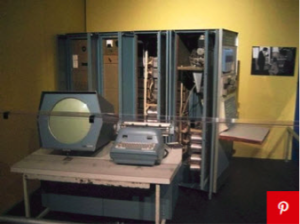 |
| Oct 1958 | Tennis for Two, often credited as 1st video game | Early video game built for entertainment purposes, Tennis for Two, designed by William Higinbotham. Created for display at the Brookhaven National Laboratory’s annual visitors’ days.
https://www.bnl.gov/about/history/firstvideo.php https://www.bnl.gov/newsroom/news.php?a=2964 |
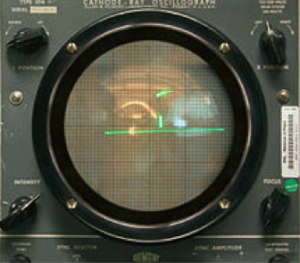 |
| 1962 | 1st widely available computer video game – Spacewar! | First widely available and influential computer video game, Spacewar! created at MIT by Steve Russell, in collaboration with Martin Graetz and Wayne Wiitanen. First known video game to be played at multiple computer installations.
https://www.thoughtco.com/history-of-spacewar-1992412 https://en.wikipedia.org/wiki/Early_history_of_video_games https://en.wikipedia.org/wiki/Spacewar!
|
 |
| 1971 | 1st commercially available arcade video game – Computer Space | First commercially available arcade video game, Computer Space, released by Nutting Associates. Designed by Atari founders Nolan Bushnell and Ted Dabney.
https://web.archive.org/web/20050121050306/http://www.marvin3m.com/arcade/cspace.htm |
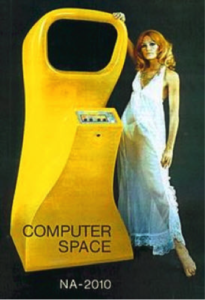 |
| Sept 1972 | 1st consumer based home video game console – Magnavox Odyssey | First consumer-based home video game console, the Magnavox Odyssey created by Ralph Baer. The console, two controllers, and a switch box connected with wires to a television set. Odyssey displayed white squares against a black field, with color static cling transparencies adhered to TV screen providing canvas to play games.
http://americanhistory.si.edu/collections/search/object/nmah_1302004 https://www.wired.com/2015/01/ralph-baer-al-alcorn-pioneer-award-dice/ https://www.lifewire.com/magnavox-odyssey-the-first-gaming-console-729587 https://en.wikipedia.org/wiki/Early_history_of_video_games https://en.wikipedia.org/wiki/Magnavox_Odyssey
|
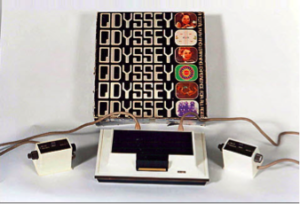 |
| Nov 1972 | 1st successful arcade video game – Pong | One of the earliest arcade video games, Pong, was the first commercially successful video game. Created by engineer Allan Alcorn, the table tennis sports game featured simple, two-dimensional graphics and was manufactured by Atari.
https://www.vanityfair.com/culture/2011/03/pong-excerpt-201103 https://www.wired.com/2015/01/ralph-baer-al-alcorn-pioneer-award-dice/ |
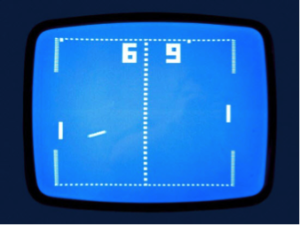 |
| Sept 1977 | Atari VCS or 2600 released | Atari released its wildly successful home console, the Video Computer System (VCS) or 2600. Over 30 million units were sold. Pac-Man was the most popular game for the Atari 2600.
https://www.atari.com/history/1972-1984-0 http://www.atarimuseum.com/videogames/consoles/2600/atari2600.html |
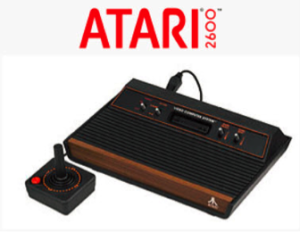 |
| 1983 | Video game market crashed in US | Following heavy saturation of low quality games, the US home video game market crashed.
Many considered the games a fad whose popularity was dying out. http://www.gamedesignireland.ie/?p=574 http://www.ign.com/articles/2011/09/21/ten-facts-about-the-great-video-game-crash-of-83 https://en.wikipedia.org/wiki/Video_game_crash_of_1983
|
 |
| Oct 1985 | Nintendo released NES and Super Mario Bros. | Following the immensely successful 1983 launch of Family Computer (Famicom) in Japan (bottom console photo), Nintendo revitalized the US video game market with their runaway hit, Nintendo Entertainment System (NES, top). NES sold over 60 million units, along with industry-defining game, Super Mario Bros., which sold over 40 million copies.
https://www.wired.com/2010/10/1018nintendo-nes-launches/ |
 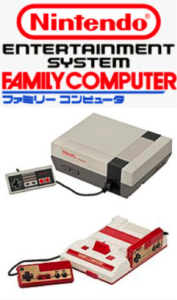 |
| July 1986 | 1st movie based on a video game –
Super Mario Bros.: The Great Mission to Rescue Princess Peach! |
Super Mario Bros.: The Great Mission to Rescue Princess Peach! was an anime film released in Japan based on the Super Mario Bros. video game. The Super Mario Bros. live-action film debuted in the US in May 1993.
https://en.wikipedia.org/wiki/Super_Mario_Bros.:_Peach-Hime_Kyushutsu_Dai_Sakusen! https://en.wikipedia.org/wiki/Super_Mario_Bros._(film)
|
 |
| Dec 1988 | 1st CD-ROM disc-based system released – PC Engine CD | NEC released the first CD-ROM disc-based system for their PC Engine in Japan. Released as TurboGrafx-16 CD in August 1990 in the US.
https://www.theguardian.com/technology/gamesblog/2013/apr/02/turbografx-16-machine-that-time-forgot https://en.wikipedia.org/wiki/TurboGrafx-16 https://i.ytimg.com/vi/zNSJ-Eh8uME/hqdefault.jpg
|
 |
| Late 1980s-Early 1990s | 1st online BBS for collecting classic video games | First online Bulletin Board Systems (BBS) for collecting classic video games appeared. | I can find BBS photos, but not a BBS for collecting classic video games.
Per Ken, wait for January advisor update to help with this.
|
| 1990 | Mario more popular than Mickey | American children were more familiar with Mario, title character of Super Mario Bros. franchise, than with Mickey Mouse.
|
 |
| Sept/ Oct 1991 | 1st issue of Digital Press published | Digital Press was released. It was the first mainstream online magazine for classic video game collectors, and was founded by Joe Santulli and Kevin Oleniacz. | 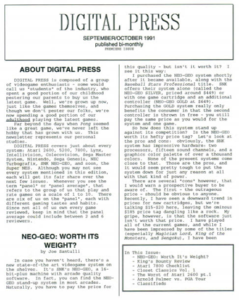 |
| Sept 1995 | AuctionWeb launched; renamed eBay in Sept 1997 | After spending Labor Day weekend at home writing code on his personal computer, Pierre Omidyar launched AuctionWeb, a site “dedicated to bringing together buyers and sellers in an honest and open marketplace.” The site was officially renamed eBay in September 1997. Over ##% of video game sales are transacted on eBay. ßTerrie: We need some connection to why eBay appears on the video game timeline; need this or some other fact to connect. |  |
| Nov 1995 | GameFAQs launched | GameFAQs, first popular video game forum, was launched by Jeff Veasey.
https://www.gamefaqs.com/boards/11-team-gamefaqs/36893099 https://en.wikipedia.org/wiki/GameFAQs
|
 |
| Aug 1999 | Classic Gaming Expo (CGE) founded | First classic video gaming convention, Classic Gaming Expo (CGE) was founded by John Hardie, Sean Kelly and Keita Iida. |  |
| July 2002 | Digital Press online classic video game collecting community formed | First widely used online collecting community, Digital Press, was formed by Joe Santulli.
https://forum.digitpress.com/forum/member.php?4-digitalpress https://forum.digitpress.com/forum/forum.php http://dpvideogames.com/about-us
|
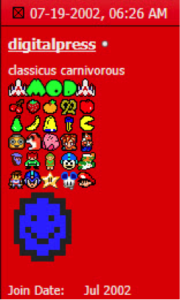 |
| Dec 2004 | Atari Flashback released | Atari released the Flashback, a plug and play multi-game miniature re-release 2600 system for playing classic games on modern TVs. Sega followed suit with their Genesis Firecore in 2009, and Nintendo followed with their NES Classic in 2016.
http://www.ign.com/articles/2004/12/15/atari-flashback https://en.wikipedia.org/wiki/Atari_Flashback |
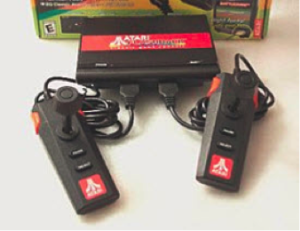 |
| Dec 2004 | Video game industry bigger than Hollywood | Video games industry generated more revenue than movie industry, breaking $10 billion in annual sales.
http://www.sfgate.com/news/article/THEY-GOT-GAME-Stacks-of-new-releases-for-hungry-2663371.php
|
 |
| Feb 2008 | Guinness World Records: Gamer’s Edition released | Guinness World Records created a separate book for gaming records called Guinness World Records: Gamer’s Edition
https://www.wired.com/2008/01/guinness-world/ http://www.ohgizmo.com/2008/01/07/coming-soon-guinness-book-of-world-records-gamers-edition/ https://en.wikipedia.org/wiki/Guinness_World_Records#Gamer’s_edition
|
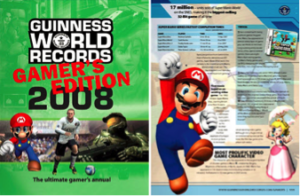 |
| Feb 2008 | 1st online video game pricing guide launched, VideoGame PriceCharts | First online pricing guide VideoGamePriceCharts.com (now pricecharting.com) launched. |  |
| April 2008 | 1st video game grading company opens | First video game grading company, VGA, opened.
https://www.engadget.com/2008/04/10/first-vga-graded-games-up-for-auction/ |
 |
| Feb 2010 | Stadium Events game sold for $13,000 on eBay | Yahoo News ran story about $13,000 Stadium Events eBay sale with link to Nintendoage.com collector site. Nintendoage.com site traffic crashed servers and user base increased rapidly.
http://www.cnn.com/2010/LIVING/03/20/mf.rich.off.video.games/index.html https://www.nbcdfw.com/news/tech/Vintage-Nintendo-Sells-for-Over-13000-on-eBay-84255392.html |
 |
| Aug 2012 | NES Legend of Zelda prototype sold for record $55,000 | Howard Phillips’ original prototype copy of NES Legend of Zelda was sold by a collector on eBay for $55,000, a record high for a single video game in 2012.
https://www.pcmag.com/article2/0,2817,2408068,00.asp
|
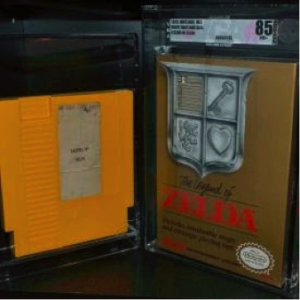 |
| July 2015 | China allowed manufacturing and sales of video game consoles | China lifted 15-year ban against manufacturing and selling video game consoles, opening gaming market to more than 1 billion new customers.
http://money.cnn.com/2015/07/27/technology/china-video-game-ban-lifted/ http://fortune.com/2015/07/27/china-game-consoles/ https://en.wikipedia.org/wiki/Video_gaming_in_China
|
 |
| Dec 2015 | Video game industry bigger than movie and music industry | The video game industry generated more revenue than the movie and music industry. Total 2015 US industry revenue topped $23.5 billion, up 5% from 2014.
MARK: Kenneth and Terrie can’t document the video game industry being larger than movies, new music sales and new book sales combined. Can you send a link to an article or report? Or stick with what we inserted here? |
 |
| April 2016 | National Videogame Museum opened | Classic Gaming Expo (CGE) founders John Hardie and Sean Kelly and CGE organizer Joe Santulli opened National Videogame Museum in Frisco, TX.
http://www.ign.com/articles/2011/07/25/classic-gaming-expo-founders-launch-videogame-history-museum
|
 |
| Feb 2017 | eSports grew to nearly $500 million | eSports (video game competitions) grew rapidly to nearly $500 million in annual sales with an audience of over 220 million viewers.
https://www.statista.com/statistics/490522/global-esports-market-revenue/ http://www.businessinsider.com/esports-market-growth-ready-for-mainstream-2017-3 http://www.goldmansachs.com/our-thinking/pages/the-rise-of-digital-gaming.html https://en.wikipedia.org/wiki/ESports
|
 |
| Feb?
March? 2018 |
Wata Games launched | Wata Games established fair, objective industry standards for grading and certifying classic video games.
|
[Insert screenshot of Wata home page when site is live] |
Josh Byerly
This guy….
Richard Lecce – Why so private?
This guy has a crazy collection of everything, but he hides in the shadows

